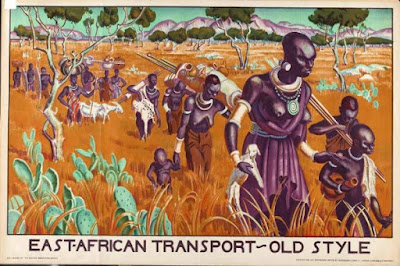The first image (above), produced 1876, was from the time of the American war of independence, or just after. Societal indicators show that men were still very much in power at this time as there is only one woman present in the image, as she is serving the food. We also know that this image was produced within the era of the slave trade as a person of colour is featured cooking on the far left of the image.
The image was actually intended to advertise a line of 'Uncle Sam Ranges', or cookers. The image dictates America, represented by the figure of Uncle Sam, in a meeting with it's allies (the three figures at the back of the image - England, the 'Dixie' South, and the West) and the rest of the world. It celebrates America as a generous nation who is extending a hand, and food, to other countries around the world. So in this sense the image acts as an early form of American propaganda.
The second image (above) comes in two parts. Both are from the 1930's, and the typography and illustration style are typical of this era. They are more 'designed' than the previous image and the rich use of colours were intended to catch the eye, which is appropriate as these images were intended to be used as a form of advertisement for the East African Transport company. Historically, these images are from the time of British colonisation across many parts of the world, and the top image depicts the 'old style' of transport in a recently colonised area of what we could assume to be an African country. It shows a traditional method of transporting goods and/or livestock by carrying them long distances. There are a range of people included in this task, including men, women and children.
The bottom image however depicts the 'new style' - the introduction of more advance 'technologies' including boats meant the transporting of goods and/or people could be done faster. In the centre of the image is a white man, standing proud with his head up, and surrounding him are people of colour. They are all male which could suggest that in this new era women and children no longer have to take on heavy workloads, but all the men have their eyes cast downwards, suggesting they are now submissive to the white man. Their outfits are also all the same which suggests they are no longer dressing in traditional clothes (as in the top image), and they may even be in a uniform of sorts.
Using a range of indicators it is possible to gain a lot of information about the history, social environment and the cultural context of these images. Many of these indicators are typical of the times in which these images were produced, making it easy to analyse this information quickly.


